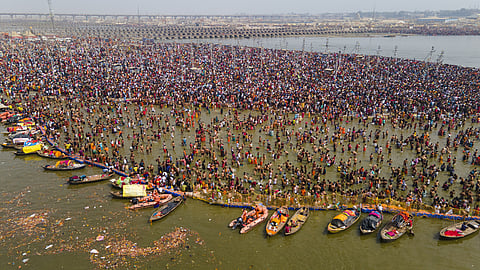

The Skanda Purana has references of the Kumbh Mela. According to many astrologers and students of Sanatan history, and also a book published by Gorakhpur’s Gita Press, called Maha Kumbh Parva, the Kumbh is as old as Rig Veda, which has shlokas mentioning the benefits of participating in it.
However, some believe that it was 8th century Hindu philosopher Adi Shankaracharya who established these four fairs, where Hindu ascetics and scholars could meet, discuss and disseminate ideas of Sanatan. In some treatises, the origins of the Kumbh are linked to the worship of River Ganga as the great force of life in the northern plains.
According to Prof D P Dubey, retired professor of ancient history, Allahabad University, and general secretary of the Society of Pilgrimage Studies, the Kumbh Mela started sometime after the 12th century CE during the Bhakti movement, a movement of the socio-religious reforms by Hindu saints and reformers.
Celebration of life and path to moksha.
While many come to the Maha Kumbh for a just dip in the holy river for atonement, some, especially, the kalpwasis, stay at the site for a month for their spiritual evolution by practising religious discipline and austerity. It is believed that taking a holy dip at the Sangam during the Maha Kumbh liberates the soul from the unending cycle of life, death, and rebirth; the soul attains moksha (salvation), considered the ultimate goal of human life.
Economic and social impact.
Beyond its spiritual significance, the Maha Kumbh invigorates local economies, providing a platform for cultural exchange and unity. It has historically been a venue for social reforms and nationalist movements during India’s struggle for independence, showcasing its role in the socio-political fabric of the nation.
